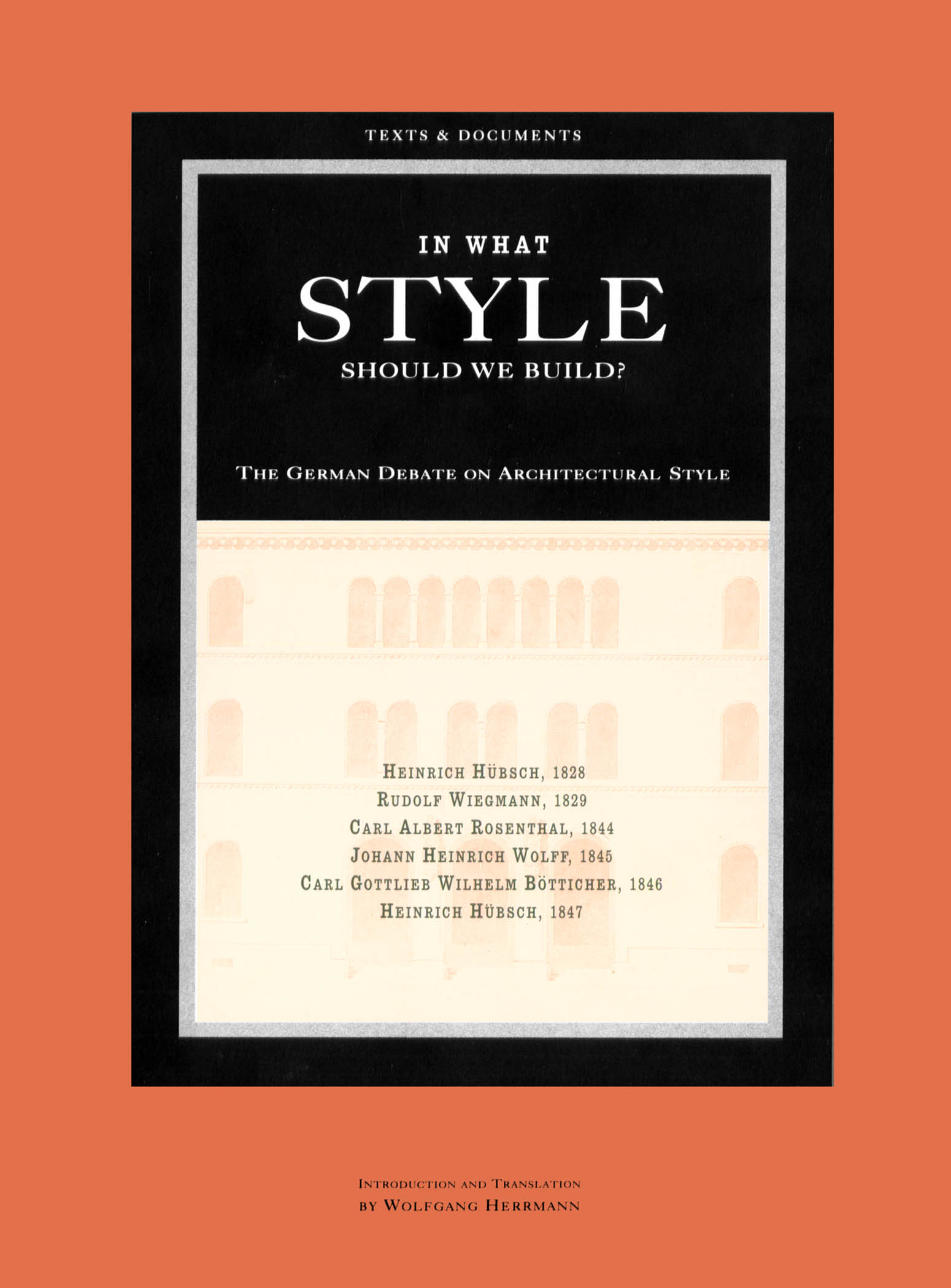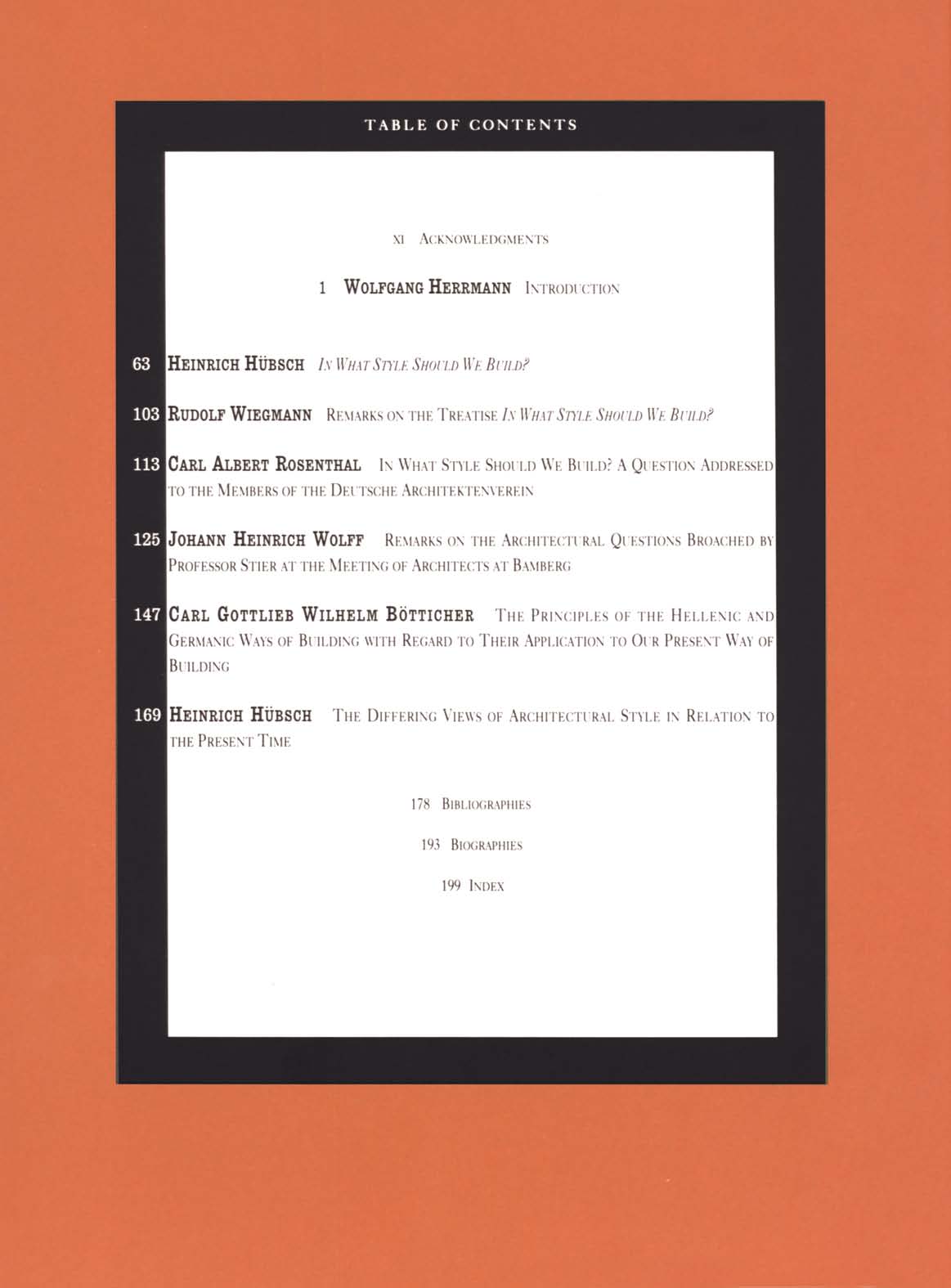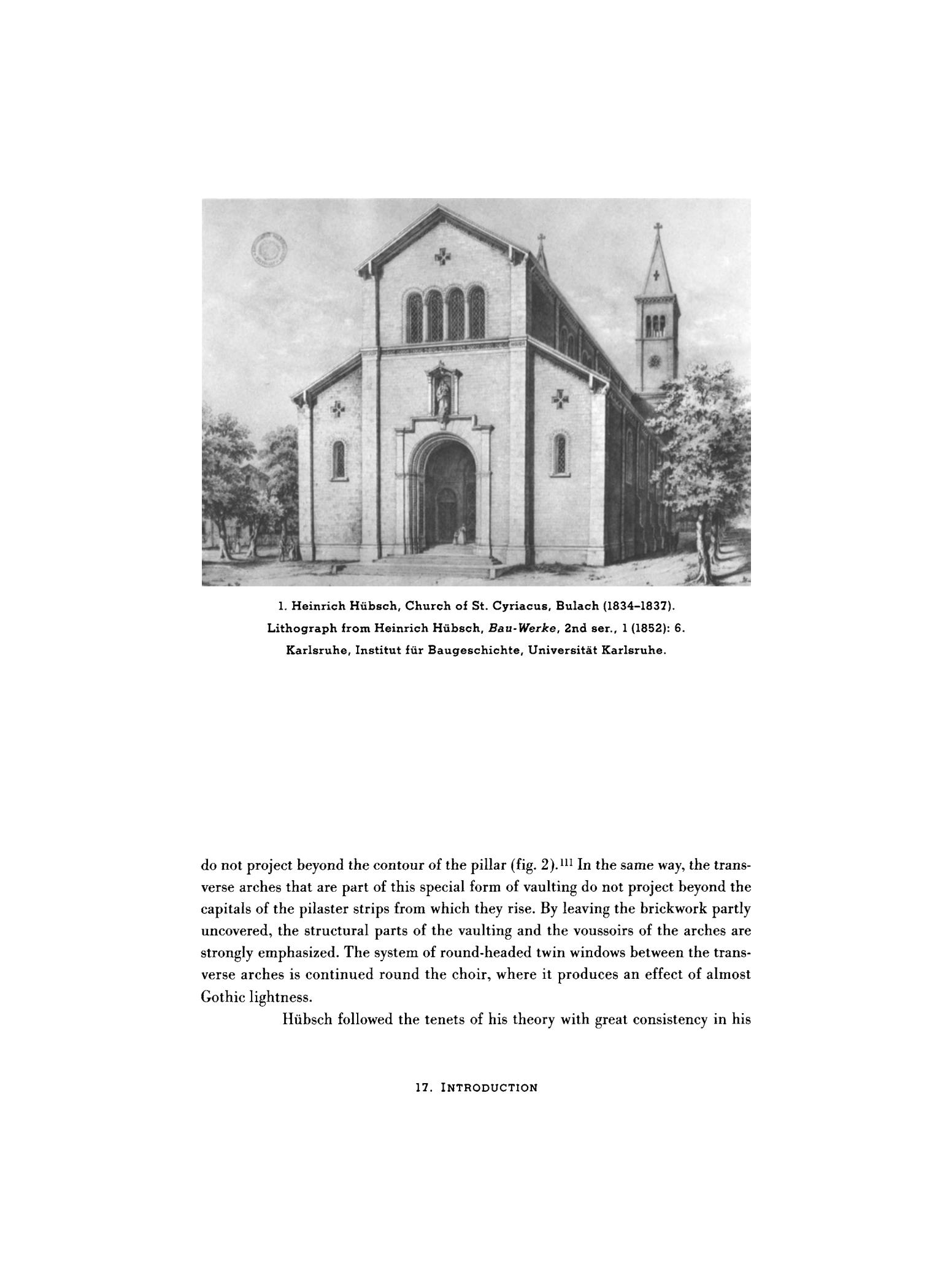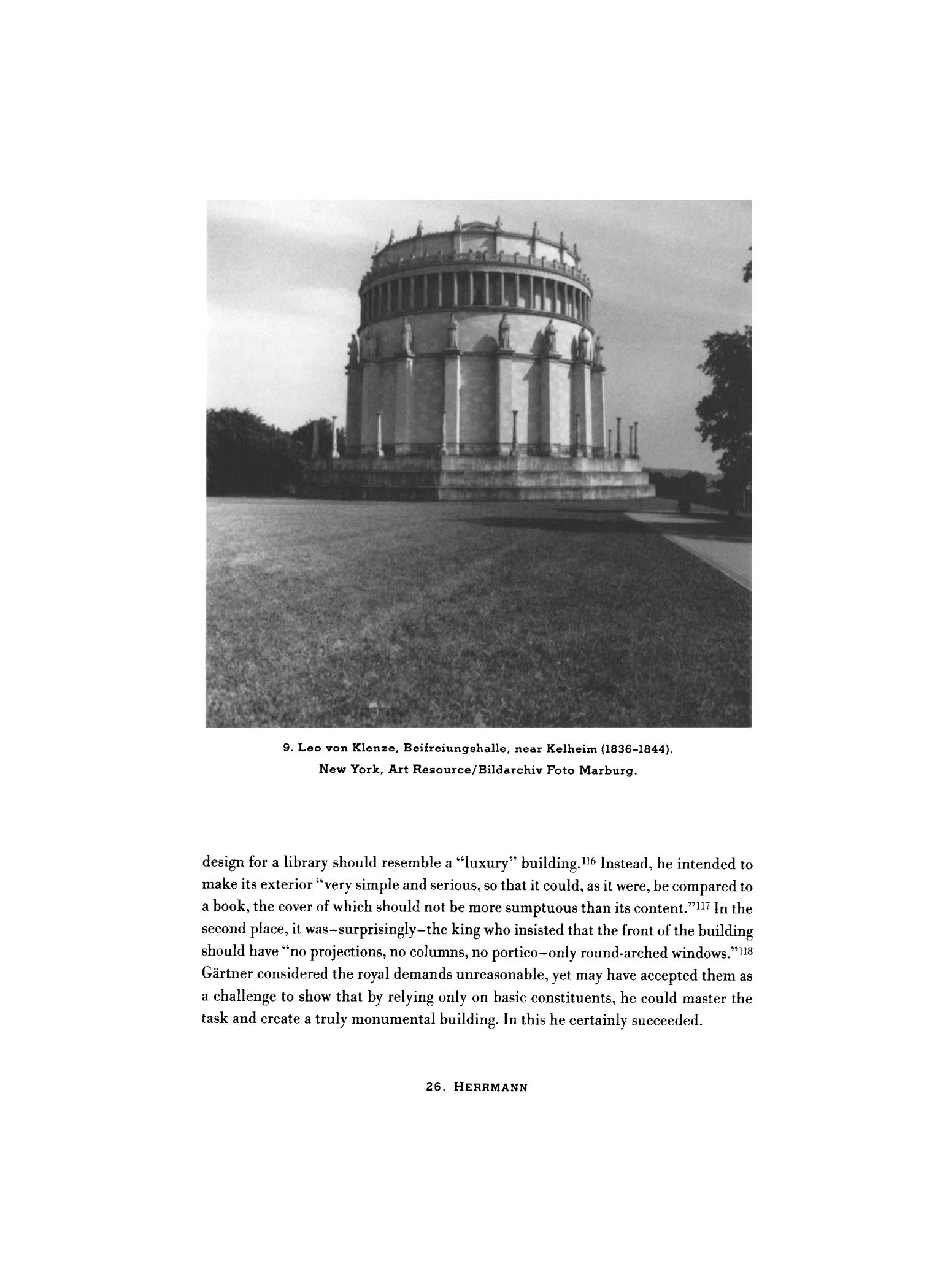|
|
In what style should we build : The German debate on architectural style. — Santa Monica, 1992  In what style should we build : The German debate on architectural style / Introduction and translation by Wolfgang Herrman. — Santa Monica : The Getty Center for the History of Art and the Humanities, 1992. — XII, 203 p., ill. (Texts & documents : A series of the Getty Center publication programs). — ISBN 0-89236-199-9; 0-89236-198-0TABLE OF CONTENTS
XI ACKNOWLEDGMENTS
1 WOLFGANG HERRMANN. INTRODUCTION
63 HEINRICH HÜBSCH. IN WHAT STYLE SHOULD WE BUILD?
103 RUDOLF WIEGMANN. REMARKS ON THE TREATISE IN WHAT STYLE SHOULD WE BUILD?
113 CARL ALBERT ROSENTHAL. IN WHAT STYLE SHOULD WE BUILD? A QUESTION ADDRESSED TO THE MEMBERS OF THE DEUTSCHE ARCHITEKTENVEREIN
125 JOHANN HEINRICH WOLFF. REMARKS ON THE ARCHITECTURAL QUESTIONS BROACHED BY PROFESSOR STIER AT THE MEETING OF ARCHITECTS AT BAMBERG
147 CARL GOTTLIEB WILHELM BÖTTICHER. THE PRINCIPLES OF THE HELLENIC AND GERMANIC WAYS OF BUILDING WITH REGARD TO THEIR APPLICATION TO OUR PRESENT WAY OF BUILDING
169 HEINRICH HÜBSCH. THE DIFFERING VIEWS OF ARCHITECTURAL STYLE IN RELATION TO THE PRESENT TIME
178 BIBLIOGRAPHIES
193 BIOGRAPHIES
199 INDEX
Acknowledgments
The five German texts presented here in English translation introduce the reader to a debate that preceded, and in scope surpassed, a similar English controversy. This debate was sparked off by the appearance of a book by Heinrich Hübsch entitled In welchem Style sollen wir bauen? (In What Style Should We Build?) in 1828. The title of Hübsch's book was also used as the title of a study by Klaus Dohmer (Munich, 1976) in which he explored the wide range of contemporary journals on architecture and art for aspects concerning controversial stylistic topics. As his subtitle indicated, Dohmer widened his search to cover the entire interval between Klassizismus and Jugendstil, whereas I confine the inquiry to a debate lasting only two decades. Dohmer’s book has nevertheless been invaluable in assisting me to sift through the material relating to this short period.
I am most grateful to Harry F. Mallgrave for the fruitful discussions we had about this project and especially for the great care he took in reading the first draft of the translation and the many suggestions and corrections he made to improve it. The final text is to a considerable extent due to the skill and experience with which David Britt undertook the comprehensive task of editing. I am greatly indebted to him. I am also very grateful to Professor Margarete Kühn for her valuable advice on selecting and procuring illustrations of Karl Friedrich Schinkel’s buildings. Finally, I wish to express my gratitude to Kurt W. Forster, Thomas F. Reese, and the Getty Center for the History of Art and the Humanities for entrusting me with the execution of the project and especially to Julia Bloomfield for her help, encouragement, and friendship while guiding the work through its many stages.
— W.H.
IntroductionWolfgang Herrmann
Heinrich Hübsch chose a straightforward question as the title for the fifty-page book that he published in 1828. Nevertheless, a complex of problems, conflicts, and uncertainties underlay its seemingly simple wording, occupying the minds of those who, like Hübsch, were concerned about the unsatisfactory state of architecture. Over the next few decades attempts were made to answer the question or at least to consider seriously its implications. Arguments and counterarguments were advanced in quick succession: traditional values were upheld against radical proposals, and a materialistic approach was opposed by an idealistic point of view. A lively debate, carried on in speeches and in print, arose among those whose professions and predilections inclined them toward an interest in the controversy—architects and, quite frequently, art critics and academics.
The main theme of the discussion-and the one on which this introductory essay will focus—was the question of style. Naturally, many other factors were pursued in the course of often quite elaborate argumentation, but it is those that relate most closely to the concept of style—such as construction, material, customs, or religious and aesthetic values—that are of particular interest.
Those men who were to take part in the style controversy were born around the turn of the century. During their formative years the mainly literary current of the Sturm und Drang period swelled into the full flood of Romanticism in all the arts; and in this movement they found the fulfillment of everything they longed for: escape from the confines of traditional rule and conventional order into a world that responded to their emotions. This generation chiefly owed its serious interest in medieval art and architecture to two men: Sulpiz Boisserée and Friedrich von Schlegel, the former through his collection of early German paintings, the latter through a publication describing medieval art and the deep impression that the cathedrals of Cologne and Strasbourg had made on him.1
____________
1. Mathilde Boisserée, ed., Sulpiz Boisserée, 2 vols. (Stuttgart: Cotta, 1862); E. Firmenich-Richartz, Die Brüder Boisserée, vol. 1, Sulpiz.und Melchior Boisserée als Kunstsammler (Jena: E. Diederichs, 1916). The Boisserée collection was moved in 1810 from Cologne to Heidelberg, where Goethe visited it in 1814 and 1815. Four years later, it was moved to Stuttgart to make it more accessible to the increasing numbers of people interested in medieval art. See W. D. Robson-Scott, The Literary Background of the Gothic Revival in Germany (Oxford: Clarendon, 1965), 161, 190, 281.
Schlegel’s work was first published in Poetisches Taschenbuch für das Jahr 1806. Friedrich von Schlegel, “Grundzüge der gotischen Baukunst,” in Sämmtliche Werke (Vienna, 1823), 6: 2. For a modern critical edition, see Hans Eichner, ed., Kritische Friedrich-Schlegel-Ausgabe (Munich, 1959), 4: 155-204.
The enthusiasm with which the younger generation responded to the newly revealed beauty of Gothic churches led many to choose architecture as the subject of their studies. Naturally, their teachers, who belonged to the preceding generation, firmly believed in the universal validity of the architectural canon of antiquity. Sooner or later, this was bound to lead to conflict. The way in which Heinrich Hübsch’s professional life developed is a good example.
Looking back to the day when, as a twenty-year-old, he had entered Friedrich Weinbrenner’s studio, Hübsch recalled how deeply impressed he had been by the “pointed-arch” style (Spitzbogenstil), “probably because the views of Goethe, Schlegel, and others had a strong influence on me.”2 It is therefore not surprising to hear that even after two years of studying the classical canon under Weinbrenner, he still held to his first conviction “that ancient architecture was unsuitable for our buildings, even when applied in the freest possible manner, and that it deprived them, as works of art, of the organic correlation of their parts.” He admitted, however, that he was still too immature to be able to suggest something else to supersede whatever had been done hitherto.3 He still preferred the “vivid splendor of Gothic architecture” to the “lifeless planes... of facades built in the antique style”4 when he decided two years later, as was then quite usual, to continue his architectural education by studying the antiquities of Rome. Moreover, as the center of the Romantic German Nazarene movement, that city had an additional attraction for him.
____________
2. Heinrich Hübsch, Bau-Werke, 1st ser. (Karlsruhe: Marx, 1838), 1.
3. Ibid.
4. Ibid.
What interested him was not so much the ancient monuments as the medieval Italian churches and the manner in which their architects had simplified the Gothic forms. He adopted these simple forms in the first year of his stay in Rome, when he worked on designing churches in the Gothic style. During his second year, he traveled to Greece. His reaction to the important event of seeing Greek architecture in its pure form, and not in the corrupted interpretation presented by succeeding generations, is most revealing. “On my return from Greece to Rome,” he recounted later, “I had completely changed my views. The prolonged contemplation of Greek monuments strengthened me in my belief as to the inadequacy of Greek architecture for our extensive needs... and at the same time convinced me... that in order to establish a new style, alive to the demands made by the present, I had to proceed more radically than I had done so far.”5
____________
5. Ibid., 2.
Thus, by 1819 he already had a goal that from then on would guide all his thoughts: to overcome what he called the “crisis of present-day architecture.”6 Hübsch felt that progress toward the aim he had set himself—the establishment of a new style-was impeded by the tenets of classical doctrine. One important task that he intended to undertake was to demonstrate the falsity of the notion of imitation that was so deeply ingrained in architectural thought. He developed its refutation in a book entitled Über griechische Architectur (On Greek Architecture), published in 1822. Unremittingly, he attacked the teachings of Aloys Ludwig Hirt, the leading theorist on classical antiquity. It was not the imitation of Greek art that was the object of Hübsch’s critique; this ideal had lost much of the appeal that it had in Johann Winckelmann’s day. The “imitation” to which he strongly objected related to the genesis of Greek architecture. According to a widely held view that had its root in Vitruvian tradition, Greek stone temples were modeled on earlier wooden buildings. Hübsch demonstrated that structural laws and the properties of the building material determined the construction as well as the form of the major parts. It was absurd, therefore, to deduce the stone structure of the Greek temple from a strange-looking, old wooden building. The idea that the trabeated system was the result of the imitation of a wooden structure ran counter to basic architectural principles.7
____________
6. Ibid.
7. Über griechische Architectur (Heidelberg: J. C. B. Mohr, 1822), 17. For the dispute between Hübsch and Hirt, see Barry Bergdoll, “Archaeology vs. History: Heinrich Hübsch’s Critique of Neoclassicism and the Beginnings of Historicism in German Architectural Theory,” The Oxford Art Journal 5, no. 2 (1982): 2-12.
These ideas matured until in 1828, Hübsch was ready to elaborate them and to speak out against the idealistic approach to architecture. “After my final return from Italy in 1824,” he wrote later, “I had a clear picture in my mind of the new style, the elements of which I then tried to develop as objectively as possible in the book ...In welchem Style sollen wir bauen? [In What Style Should We Build?].”8
____________
8. Hübsch (see note 2), 2.
To this end he reviewed the major architectural systems. These had also been the subject of a book published a year before Hübsch’s treatise by the well-known historian Christian Ludwig Stieglitz. Yet in their objectives and final conclusions the two authors differed greatly. Stieglitz gave a historical account of the manner of building as it differed among nations. Resignedly, he concluded that for the present, “all that can be done, in view of the impossibility of creating new forms, is to imitate.”9 But Hübsch, pursuing an uncharted route, undertook an analytical examination of the major styles and concluded with confidence that the new style, as outlined by him, would “freely evolve and respond to any fair demand without hesitation.”10
____________
9. Christian Ludwig Stieglitz, Geschichte der Baukunst vom frühesten Alterthume bis in die neueren Zeiten (Nuremberg: F. Campe, 1827), 467.
10. Heinrich Hübsch, In welchem Style sollen wir bauen? (Karlsruhe: Chr. Fr. Müller Hofbuchhandlung und Hofbuchdruckeren, 1828), 52 [99].
Hübsch admitted four factors as the basic determinants of style: material, technical experience, climate, and present needs.11 By limiting his analysis of ancient styles to what might be called materialistic factors, he could have found support in, and might indeed have been influenced by, a debate between Johann Karl Schorn and Carl Friedrich von Rumohr over the nature of style that had taken place in an exchange of letters published in Kunst-Blatt a few years earlier.12 Rumohr (whom Hübsch knew well enough to send a drawing to from Greece)13 countered Schorn’s idealistic approach by stressing the clear distinction that had to be made between, on the one hand, the raw material to be subjected to artistic treatment and, on the other, the ideas and their artistic representation in the final work of art. Only the former, the material as treated by the artist, incorporated what Rumohr called style. While he admitted that this concept of style meant that it evolved in an inferior and merely technical sphere, he emphasized that it was just for this reason that it had a separate existence and could be perceived separately in a work of art.
____________
11. Ibid., 13 [71].
12. “Über Styl und Motive in der bildenden Kunst,” Kunst-Blatt 6 (1825), no. 1, 1–4; no. 75, 297-300; no. 76, 301–4.
13. Carl Friedrich von Rumohr, Italienische Forschungen (Berlin, 1827–1831), part 3, 195: “Von Herrn Professor Hübsch zu Frankfurth erhielt ich, kurz nach Beendigung seiner fruchtbaren Reise durch Griechenland, die Seitenansicht einer Kirche in den Umgebungen von Athen...”
Hübsch may or may not have been aware of Rumohr’s theoretical arguments, but the extraordinary way in which he restricted his analysis of the major architectural systems to the technical sphere makes it evident that he too considered the concept of style to be unrelated to aesthetic qualities. Aiming at a new style, he consequently focused his attention on those four principal factors that had in the past alone determined the major styles.
Hübsch first listed the essential parts of a building: walls, ceiling, roof, supports, windows, and doors. These were the elements of style; their forms varied according to the material used.14 The Greeks, using hard marble or ashlar as building materials, developed a system in which all parts clearly conveyed the function they were to fulfill: columns appeared only where they supported an architrave, piers only where they strengthened the wall, and the architrave only where it was needed to carry the ceiling. In this way, they developed an architecture that “excelled in simplicity of composition.”15 Next to material, it was what Hübsch called “technostatic experience” that had an important influence on the creation of style.16 The Romans, not comprehending the logic of the structural principle on which the Greek style was based, changed it into a “mere sham and show architecture.”17 However, by using small-sized stones, they introduced the vault as a new structural element. While architecture declined with the end of the Roman Empire, technostatic experience was never lost and even progressed.18 Over the centuries constructions became bolder, while less material was needed to span spaces. A highly developed vaulting technique and the introduction of the pointed arch (Spitzbogen), created a system in which everything derived from the construction of the vault.19 The medieval system of the vault was the opposite of the Greek post-and-lintel system. “Essentially,” Hübsch concluded, “there are only two original styles: one with straight, horizontal stone architraves; the other with curved vaults and arches.”20
____________
14. Hübsch (see note 10), 5, 7 [66, 67–68].
15. Ibid., 18 [77].
16. Ibid., 9–10 [68–69].
17. Ibid., 21 [79].
18. Ibid., 9, 31 [69, 86].
19. Ibid., 42 [93].
20. Ibid., 8 [68].
The last two sections of the treatise are taken up by a comparison of two styles whose basic structural form was the arch: the rounded (i.e., the Rundbogenstil) and the pointed. The existence of a transitional period, in which the pointed arch was not acutely pointed and differed little from the Rundbogen, made it difficult for Hübsch to opt for one or the other, but in the end he decided for the latter because, he said, it conformed to the practical theory that he had developed in his book.21 One rather suspects that it was his taste that turned the scale in favor of the Rundbogenstil and not the “cold logic” by which—as he said later—a new style should be judged.22
____________
21. Ibid., 51–52 [99–100].
22. Heinrich Hübsch, Die Architektur und ihr Verhältniß zur heutigen Malerei und Skulptur (Stuttgart and Tübingen: J. G. Cotta, 1847), 189–90 [172–73].
It is hardly surprising that Hübsch’s view of the genesis of style was not accepted. Soon after his essay was published, the Kunst-Blatt carried a review written by Rudolf Wiegmann, who—nine years junior to Hübsch—was still on a study tour in Italy.23 Wiegmann criticized Hübsch for attaching a meaning to the term “style” that related to material and construction. “The whole treatise,” he exclaimed, “seems to be pervaded by the notion that matter dominates mind.”24
____________
23. Rudolf Wiegmann, “Bemerkungen über die Schrift: In welchem Styl sollen wir bauen? von H. Hübsch,” Kunst-Blatt 10 (1829): no. 44, 173–74; no. 45, 177–79; no. 46, 181–83 [103–12],
24. Ibid., 177 [105].
<...>
Sample pages 
Download link (pdf, yandexdisk; 16,3 MB).
The electronic version of this issue is published only for scientific, educational or cultural purposes under the terms of fair use. Any commercial use is prohibited. If you have any claims about copyright, please send a letter to 42@tehne.com.
27 января 2022, 21:14
0 комментариев
|
Партнёры
|






Комментарии
Добавить комментарий